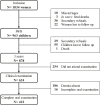Early risk factors for posterior crossbite and anterior open bite in the primary dentition
- PMID: 26998889
- PMCID: PMC8600852
- DOI: 10.2319/102715-723.1
Early risk factors for posterior crossbite and anterior open bite in the primary dentition
Abstract
Objective: To investigate risk factors specific to posterior crossbite and anterior open bite at the age of 3 years.
Materials and methods: The study included 422 children of the French EDEN mother-child cohort. The main outcomes were the presence of posterior crossbite and anterior open bite assessed by dentists at 3 years. Social characteristics (collected during pregnancy), neonatal characteristics (collected at birth), duration of breast-feeding (collected prospectively), sucking habits at 3 years, and open lips (as a proxy for mouth breathing) were studied and two logistic regressions conducted.
Results: Preterm birth appears to be a risk factor specific for posterior crossbite (OR: 3.13; 95% CI: 1.13-8.68), whereas small for gestational age seems to be associated with a lower risk of posterior crossbite (OR: 0.32; 95% CI: 0.12-0.87). Ongoing pacifier or thumb sucking at 3 years is a risk factor for both posterior crossbite and anterior open bite.
Conclusions: Children born preterm seem to be more at risk for posterior crossbite than those born at term. Different mechanisms may be involved in posterior crossbite and anterior open bite.
Keywords: Child; Crossbite; Epidemiology; Open bite; Orthodontics; Preterm birth.
Similar articles
-
Feeding and nonnutritive sucking habits and prevalence of open bite and crossbite in children/adolescents with Down syndrome.Angle Orthod. 2010 Jul;80(4):748-53. doi: 10.2319/072709-421.1. Angle Orthod. 2010. PMID: 20482363 Free PMC article.
-
[Effects of breast-feeding duration, bottle-feeding duration and oral habits on the occlusal characteristics of primary dentition].Beijing Da Xue Xue Bao Yi Xue Ban. 2016 Dec 18;48(6):1060-1066. Beijing Da Xue Xue Bao Yi Xue Ban. 2016. PMID: 27987514 Chinese.
-
The effect of early childhood non-nutritive sucking behavior including pacifiers on malocclusion: a randomized controlled trial.Eur J Orthod. 2024 Oct 1;46(5):cjae024. doi: 10.1093/ejo/cjae024. Eur J Orthod. 2024. PMID: 39119981 Free PMC article. Clinical Trial.
-
Sucking habits in Saudi children: prevalence, contributing factors and effects on the primary dentition.Pediatr Dent. 1997 Jan-Feb;19(1):28-33. Pediatr Dent. 1997. PMID: 9048410 Review.
-
Self-correction of posterior crossbite in childhood: a systematic review of long-term follow-up studies.Eur J Orthod. 2023 Nov 30;45(6):739-746. doi: 10.1093/ejo/cjad034. Eur J Orthod. 2023. PMID: 37454178
Cited by
-
Pacifier Use and Its Influence on Pediatric Malocclusion: A Scoping Review of Emerging Evidence and Developmental Impacts.Dent J (Basel). 2025 Jul 14;13(7):319. doi: 10.3390/dj13070319. Dent J (Basel). 2025. PMID: 40710164 Free PMC article. Review.
-
A longitudinal study of facial asymmetry in a normal birth cohort up to 6 years of age and the predisposing factors.Eur J Orthod. 2023 Jul 31;45(4):396-407. doi: 10.1093/ejo/cjad012. Eur J Orthod. 2023. PMID: 37036798 Free PMC article.
-
Impact of primary dentition malocclusion on the oral health-related quality of life in preschoolers.Prog Orthod. 2021 Nov 22;22(1):38. doi: 10.1186/s40510-021-00384-2. Prog Orthod. 2021. PMID: 34806119 Free PMC article.
-
Intermittent hypoxia in neonatal rodents affects facial bone growth.PLoS One. 2023 Oct 11;18(10):e0282937. doi: 10.1371/journal.pone.0282937. eCollection 2023. PLoS One. 2023. PMID: 37819881 Free PMC article.
-
Risk factors for anterior open bite: A case-control study.Dent Res J (Isfahan). 2020 Sep 7;17(5):388-394. eCollection 2020 Sep-Oct. Dent Res J (Isfahan). 2020. PMID: 33343848 Free PMC article.
References
-
- Duncan K, McNamara C, Ireland AJ, Sandy JR. Sucking habits in childhood and the effects on the primary dentition: findings of the Avon Longitudinal Study of Pregnancy and Childhood. Int J Paediatr Dent. 2008;18:178–188. - PubMed
-
- Dimberg L, Bondemark L, Soderfeldt B, Lennartsson B. Prevalence of malocclusion traits and sucking habits among 3-year-old children. Swed Dent J. 2010;34:35–42. - PubMed
-
- O’Byrn BL, Sadowsky C, Schneider B, BeGole EA. An evaluation of mandibular asymmetry in adults with unilateral posterior crossbite. Am J Orthod Dentofacial Orthop. 1995;107:394–400. - PubMed
-
- Andrade AS, Gaviao MB, Derossi M, Gameiro GH. Electromyographic activity and thickness of masticatory muscles in children with unilateral posterior crossbite. Clin Anat. 2009;22:200–206. - PubMed
-
- Lam PH, Sadowsky C, Omerza F. Mandibular asymmetry and condylar position in children with unilateral posterior crossbite. Am J Orthod Dentofacial Orthop. 1999;115:569–575. - PubMed
MeSH terms
LinkOut - more resources
Full Text Sources
Other Literature Sources


